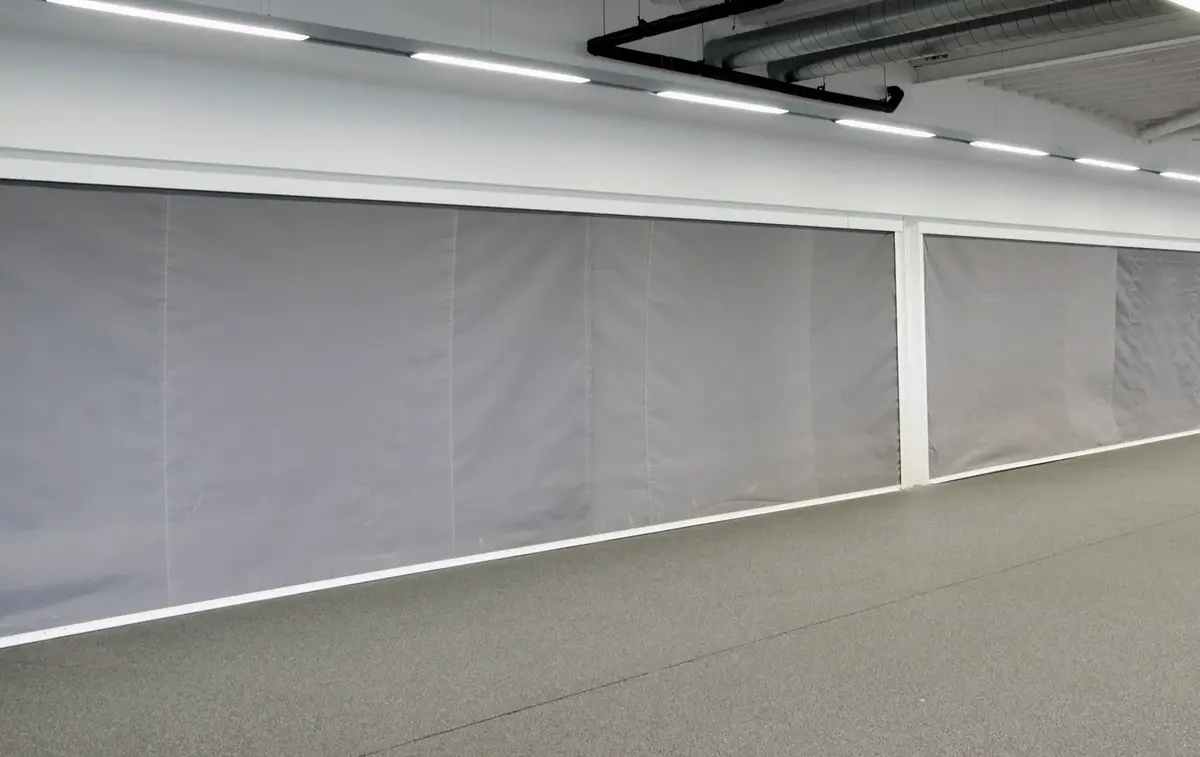Building a Barrier Against Fire with Smoke Curtains

While fire alarms and sprinklers are the first line of defense in restricting fire damage, another technology, largely unseen, helps in protecting lives: smoke curtains.
Fire safety in buildings isn’t just about flames. Shockingly, around half of all fire deaths are caused by smoke inhalation, not burns. That’s why fire safety plans focus heavily on keeping smoke under control, and that’s where smoke curtains come in.
Smoke curtains are specialized fire safety devices built to contain smoke and heat during a fire. They are typically made from fire-resistant fabric and deploy automatically or manually as required.
Think of them as physical walls that rise from the ceiling or descend from the sides, creating a barrier to compartmentalize the building.
How do they work?
Imagine a fire erupting on one floor of a multi-story building.
Without smoke curtains, smoke and heat would quickly rise through stairwells and elevator shafts, engulfing upper floors – making escape quite difficult.
Smoke curtains deployed here act as a barrier, stopping smoke infiltration to other areas. The occupants on unaffected floors get to safety this way and firefighters have clear access to the fire source.
Benefits of smoke curtains:
- Compartmentalization: Smoke curtains work well to compartmentalize a building, creating smoke-free zones. This improves visibility for evacuation and also isolates the fire, making it easier for firefighters to control it.
- Improved visibility: By containing smoke, these curtains can improve visibility inside the building, especially in corridors and stairwells. This is necessary for both occupants crossing through escape routes and firefighters battling the blaze.
- Life safety havens: In some cases, smoke curtains can create temporary safe havens within a building by effectively sectioning off smoke and heat. These havens provide refuge for occupants who may be unable to evacuate immediately due to mobility limitations or location inconveniences within the building.
- Damage reduction: Smoke curtains limit smoke and heat spread, reducing damage to the building. This reduces fire damage costs and preserves valuables.
Types of smoke curtains:
Vertical smoke curtains: These curtains deploy downwards from ceilings, typically used to seal doorways, openings, or atriums. They prevent smoke from passing vertically through these openings.
Horizontal smoke curtains: These curtains deploy horizontally across large open spaces like atriums or auditoriums. They create a physical barrier that stops smoke from rising to upper floors.
Draft Curtains: These are for industrial settings where hot gases can build up near the ceiling. Draft curtains disrupt these layers, allowing for better ventilation and smoke removal with the help of fans.
Perimeter Curtains: These are like invisible walls around staircases and escalators. They keep smoke contained in that area, preventing it from spreading to other parts of the building.
Smoke curtains are not a standalone solution. They work best when added to a comprehensive fire safety strategy, which already has functioning fire alarms, sprinklers, fire-resistant materials, and well-defined evacuation plans. It’s this multi-layered approach that secures the best defense against fire hazards.
Fire alarms are scary and leave you panicked. Here’s what you can do for safety in such a situation:
- 1. Evacuate fast: Don’t waste time, get out of the building quickly.
- 2. Follow the plan: If there’s an evacuation plan, follow it. If not, find the nearest exit.
- 3. Feel the door: Before opening, check if it’s hot with the back of your hand.
- 4. Stay low, go slow: Crawl on the floor if visibility is low to avoid smoke.
- 5. Save Yourself : Focus on your own safety first, then alert authorities.
- 6. Stay outside: Don’t re-enter, wait for firefighters.
- 7. Call the fire department: Report the fire and any trapped individuals.
By following these steps and staying informed, you can be better prepared in case of a fire.
For more information, visit https://a1sgroup.com
